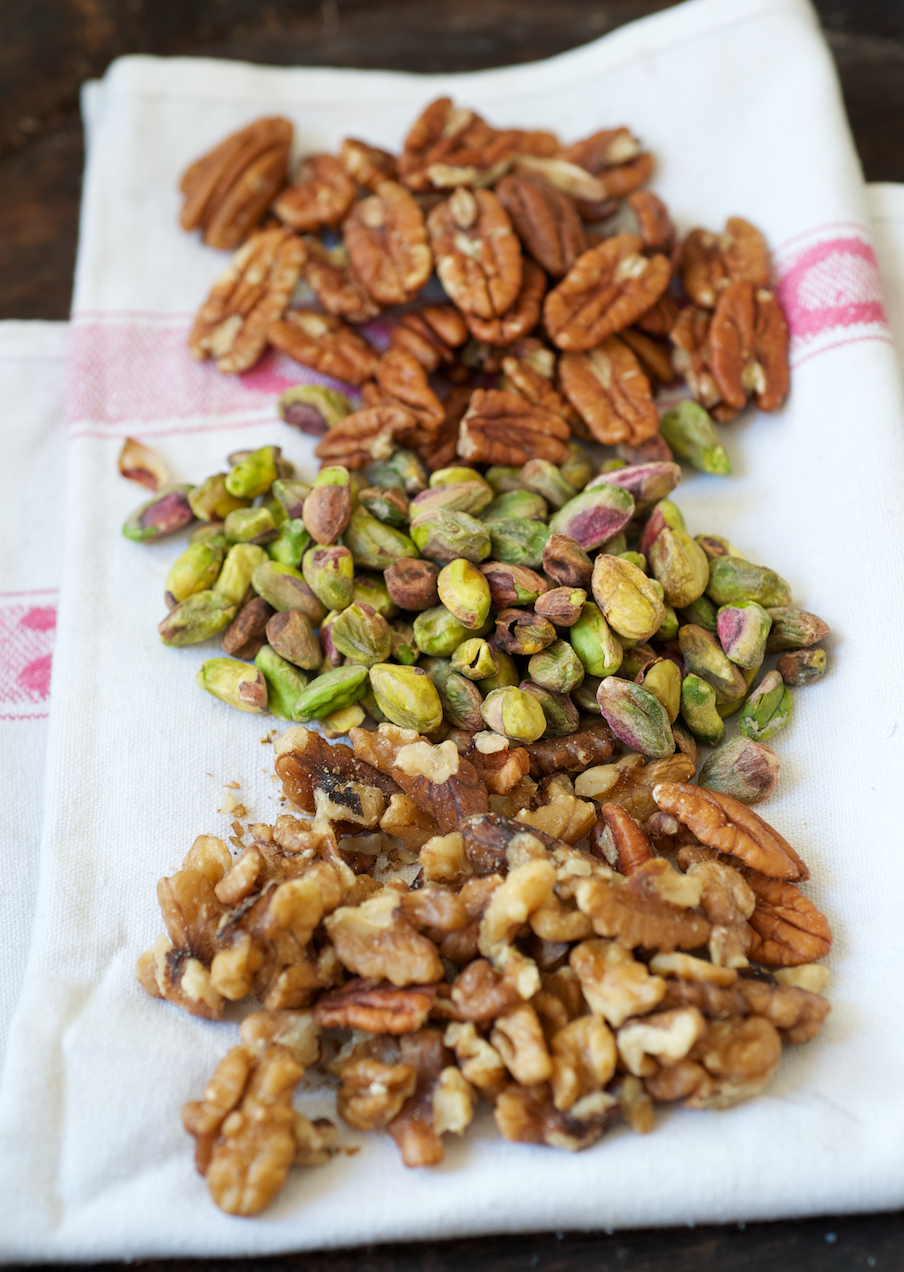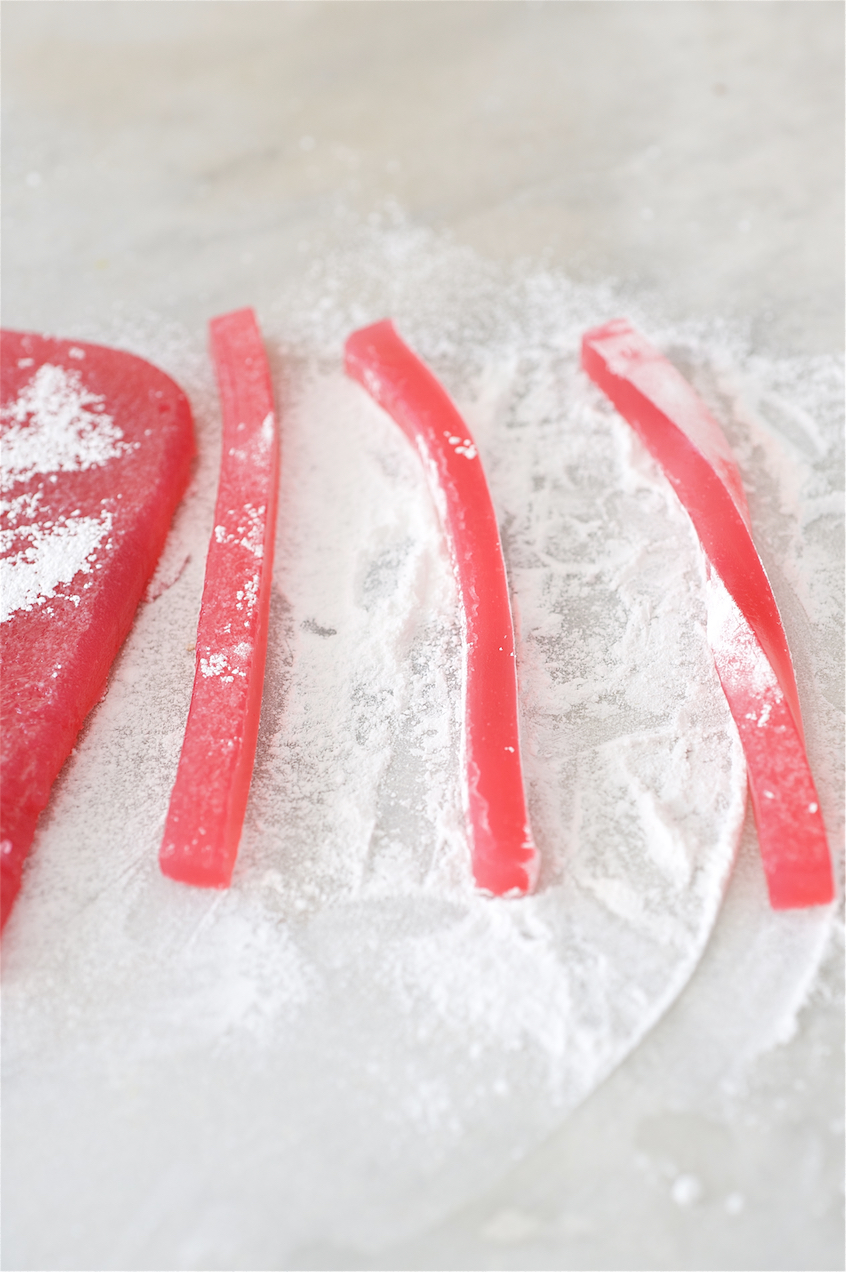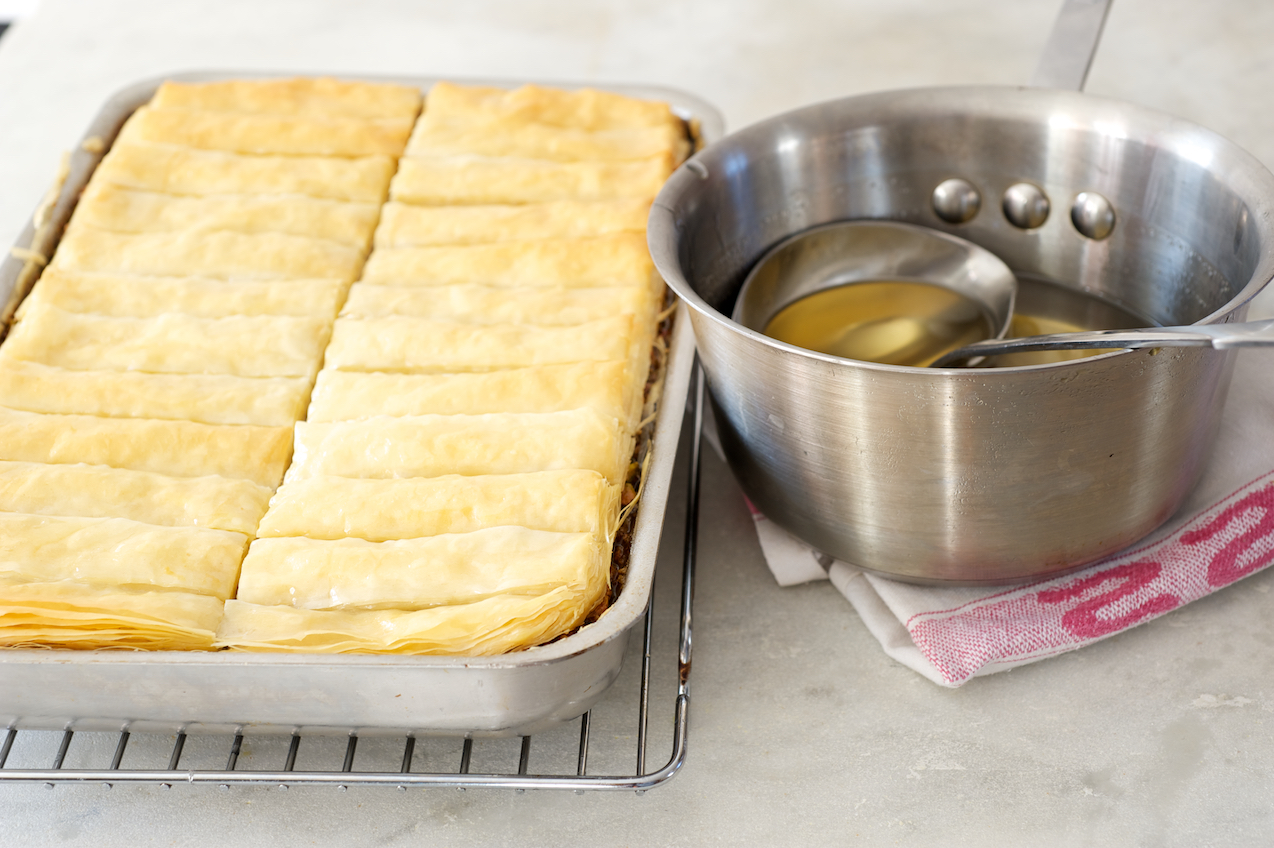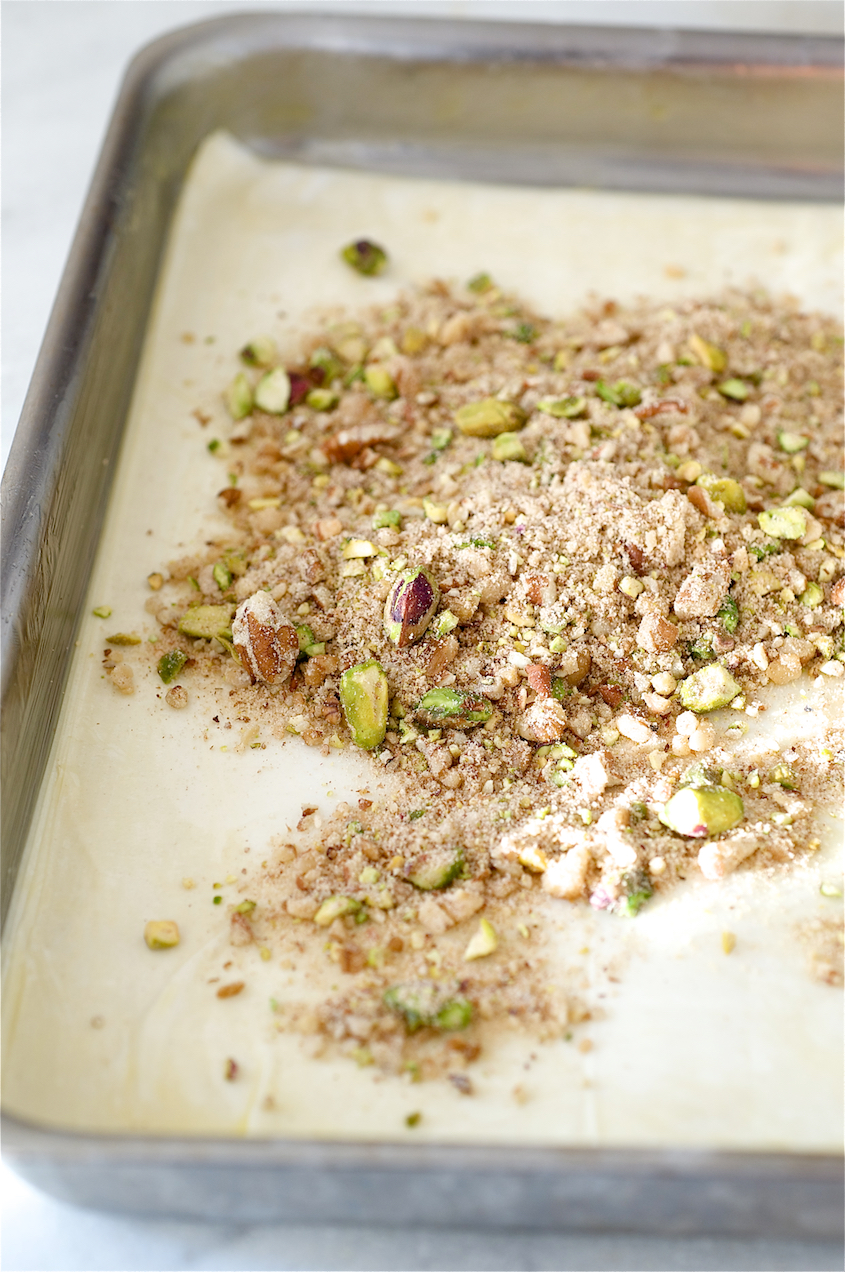

Pistachio and Walnut Baklava with Rhubarb and Rose Delights
-
Prep time:
-
Cook time:
Total time:
Portion/Yield:
Serves 24Difficulty:
Experienced
Living in a country where so many culinary cultures meet, one is bound to be inspired to borrow, exchange and adapt recipes from home and away. The creativity for this recipe is sparked by the very first of the new season’s forced rhubarb. The floral fragrance and colour of this cooked rhubarb reminds me of roses and the last time I made Turkish delight. So, filled with inspiration, I set off to create this recipe for a bit of seasonal fun. This recipe only works with forced rhubarb as you rely on the fragrance of the bright pink thin skin – the outdoor rhubarb will not deliver the same effect and the flavour will definitely be earthier.
Baklava is well received in our household – it’s so easy to make, but is also so easy to get wrong. My secret is that you must follow the recipe to the letter. The layering of the filo sheets is very important and before baking, you must cut through the top layers of filo pastry – if you do not do this, your baklava will not be able to absorb the syrup and it will be dry. The final secret is in the soaking of the baklava once cooked – it must be covered with the syrup, a ladleful at a time, and then it must be left to rest at room temperature for at least 12 hours. It’s a labour of love, but your efforts and patience will be rewarded with this truly delicious dish.
I also made a great discovery when developing this recipe – that coriander and rhubarb make the most amazing taste combination. Coriander has a slight citrus fragrance and it works magically with the rhubarb. An unusual but genius combination!



Ingredients & Method
For the rhubarb and rose delights
- 350ml cold water
- 225g caster sugar
- 225g new season forced rhubarb, washed, drained and chopped into small pieces
- juice of 1 lemon
- 5 leaves of gelatine
- 25g cornflour, plus 1 tablespoon cornflour
- 2 tablespoons rosewater
- 2 tablespoons icing sugar
For the rhubarb and apple purée
- 125g (prepared weight) eating apples (preferably Russet), peeled, cored and chopped
- 100ml cold water
- 125g cooked rhubarb pulp from the rhubarb and rose delights (see above)
For the pistachio and walnut baklava
- 300g shelled pistachios
- 300g shelled walnuts
- 2 teaspoons ground cinnamon
- 300g light soft brown sugar
- 16 sheets of chilled fresh or frozen (defrosted) filo pastry (each sheet about 40 x 30cm)
- 150g unsalted butter, melted
- 750g caster sugar
- 750ml cold water
- 1 cinnamon stick
- finely grated zest and juice of 1 lime
- finely grated zest and juice of 1 lemon
- 45g clear honey
- 1 teaspoon whole cloves
- additional chopped pistachios and tiny sprigs of fresh coriander cress, to decorate
First, make the rhubarb and rose delights. Put 300ml of the water into a saucepan with the caster sugar, rhubarb and lemon juice. Cook over a low heat, stirring until the sugar has dissolved, then increase the heat a little and simmer for 5 minutes. Remove from the heat and leave the rhubarb mixture to infuse for 10 minutes, then pass the rhubarb through a sieve, reserving the juices and pulp separately (the pulp will be used for the rhubarb and apple purée). Line a 22 x 15cm baking tray with cling film and set aside. Soak the gelatine in cold water until it has softened, then gently squeeze the gelatine to remove the excess water. In a small bowl, blend the 25g cornflour with the remaining 50ml of water until smooth. Measure 450ml of the bright pink rhubarb juice into a non-stick saucepan, add the gelatine and the dissolved cornflour and heat gently, stirring until the gelatine has dissolved, then bring up to a rolling boil. Keep the mixture at a steady rolling boil for 12–14 minutes or until the syrup reaches a temperature of 112–115°C (soft ball stage – see Cook’s Notes), stirring continuously to prevent the mixture from catching and burning. Remove from the heat and stir in the rosewater. Pour the mixture into the prepared baking tray, then leave to cool and keep at room temperature for about 12 hours or until the mixture is set; do not refrigerate.
Once the rhubarb and rose jelly is set, cut it into 24 or 48 pieces. Combine the remaining 1 tablespoon of cornflour and the icing sugar in a bowl, then roll the jellies in this mixture, coating them all over. Keep the jellies in an airtight container in a cool place for up to 3 days; do not refrigerate.
For the rhubarb and apple purée, put the apples in a small saucepan with the water and bring to the boil, then cover and cook gently for 5 minutes or until the apples are soft. Remove from the heat and transfer the apples and juices to a blender, add the rhubarb pulp and blend together until smooth, then pass the purée through a fine sieve into a bowl. Cover and chill the purée until needed (keep refrigerated and use within 3 days). For the baklava, preheat the oven to 180°C/Gas Mark 4. Put the nuts, cinnamon and brown sugar into a food processor and pulse until the nuts are all finely chopped to roughly the same size – not powdered but a coarse crumb texture.
Cut the filo pastry sheets in half so they each measure about 20 x 30cm. Assemble the baklava in a greased baking tin measuring 32 x 22 x 3.5cm. Brush 10 filo sheets with melted butter and lay them, one on top of the other, over the base of the baking tin, then spread half of the nuts and sugar mixture evenly over the filo. Brush another 10 filo sheets with melted butter and lay these over the nut mixture, one on top of the other, then press them down gently. Spread the remaining nut and sugar mixture evenly over the top. Brush the remaining 12 filo sheets with the remaining melted butter, lay these over the nut mixture, one on top of the other, then press them down gently.
Using a sharp paring knife, cut through the first 12 layers of filo to make 24 even-sized pieces. Bake the baklava in the oven for about 45 minutes or until golden brown and crisp.
While the baklava is baking, make the syrup. Put the caster sugar and water into a saucepan, together with all the remaining ingredients (except the decoration). Bring to the boil, then reduce the heat and simmer for 15 minutes or until the syrup has thickened to a coating consistency. Pass the syrup through a fine sieve into a jug and keep hot.
Once the baklava is cooked, remove it from the oven and leave to rest for 5 minutes, then cut the baklava all the way through to the base of the baking tin. Gradually ladle the hot syrup over the hot baklava. It will take a bit of time for the baklava to absorb all the syrup, so keep adding it a ladleful at a time, until it’s all used up. Leave the baklava to cool and rest at room temperature for a minimum of 12 hours or overnight.
To serve, remove each piece of baklava from the baking tin and place on a serving plate. Spoon 2 teardrops of the rhubarb and apple purée on to each plate, then place 1 or 2 rhubarb and rose delights alongside. Decorate each plate with a few chopped pistachios and tiny sprigs of coriander cress and serve.
Cook’s Notes
When making the rhubarb and rose delights, if you don’t have a jam thermometer, place a small plate in the freezer, then put a teaspoonful of the hot syrup on to the chilled plate. If the syrup sets and you can roll the mixture into a soft, pliable ball, then it’s ready.
Baklava will keep in an airtight container for up to 1 week in a cool, dry cupboard.
